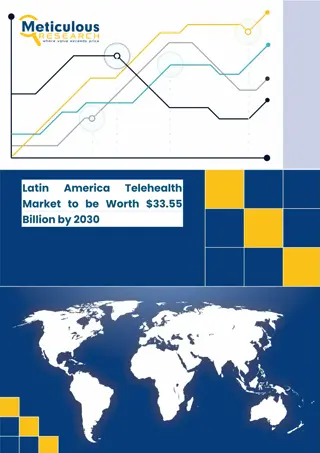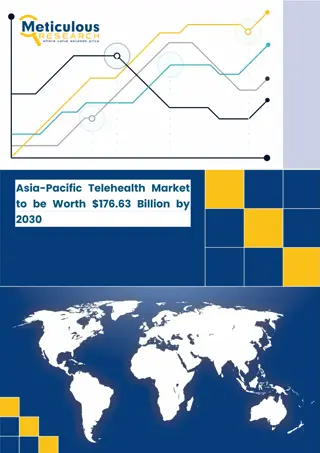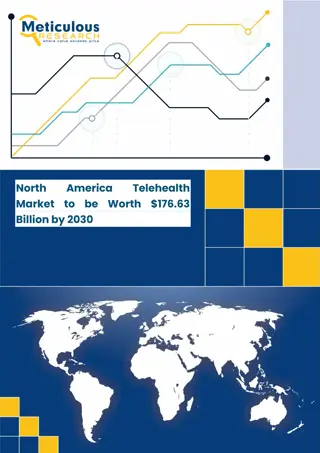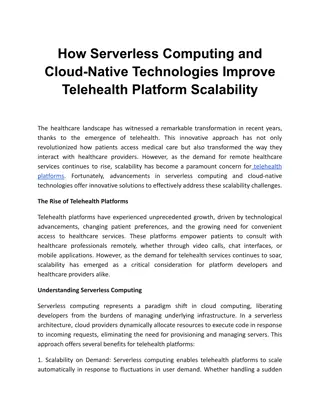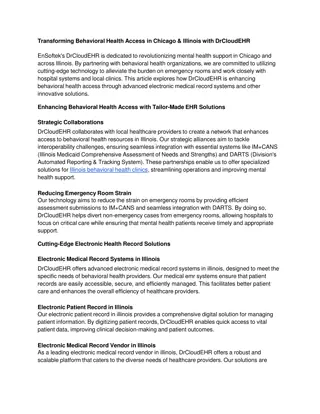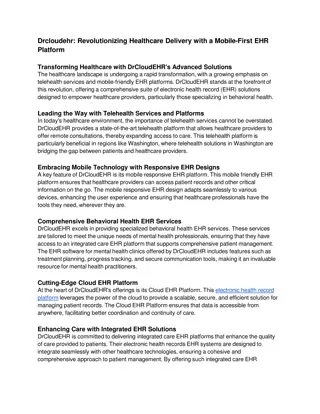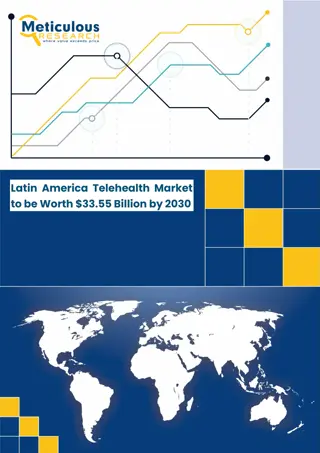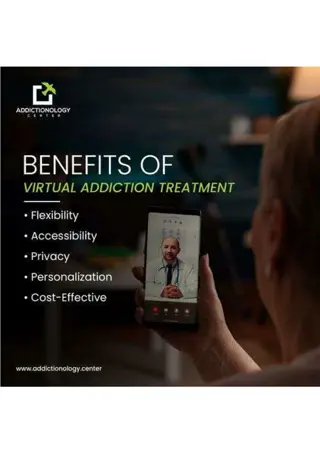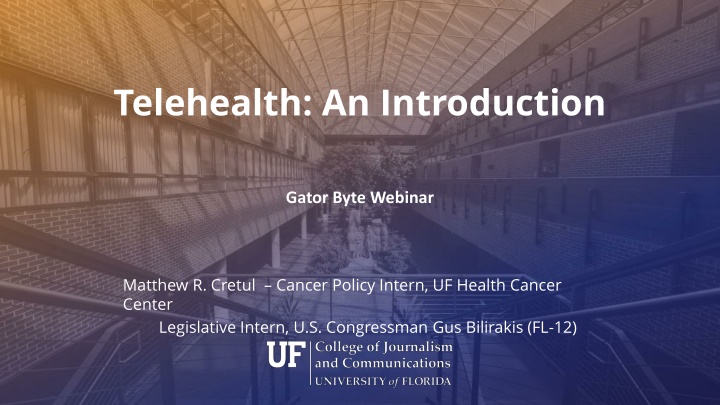
Understanding the Evolution of Telehealth Technology
Explore the historical journey and key components of telehealth technology, including definitions, uses, and communication hierarchy. Discover how telehealth has evolved from its early beginnings to its current role in healthcare delivery.
Download Presentation

Please find below an Image/Link to download the presentation.
The content on the website is provided AS IS for your information and personal use only. It may not be sold, licensed, or shared on other websites without obtaining consent from the author. If you encounter any issues during the download, it is possible that the publisher has removed the file from their server.
You are allowed to download the files provided on this website for personal or commercial use, subject to the condition that they are used lawfully. All files are the property of their respective owners.
The content on the website is provided AS IS for your information and personal use only. It may not be sold, licensed, or shared on other websites without obtaining consent from the author.
E N D
Presentation Transcript
Telehealth: An Introduction Gator Byte Webinar Matthew R. Cretul Cancer Policy Intern, UF Health Cancer Center Legislative Intern, U.S. Congressman Gus Bilirakis (FL-12)
Objectives Through today s presentation, you will gain an understanding of: What telehealth is, where it came from, and how it is used Barriers associated with the greater implementation of telehealth What current and future considerations go into crafting telehealth implementation What proposed bills are currently making their way through the federal legislative process
Telehealth Defined Q: What is Telehealth? A: Depends on who you ask. The United States Federal Government defines defines telehealth as: The State of Florida Department of Health defines defines telehealth as: the use of electronic information and telecommunication technologies to support long- distance clinical health care, patient and professional health-related education, public health, and health administration the use of synchronous (real- time information sharing) or asynchronous (relay of information with lag time) telecommunications technology by a telehealth provider to provide health care services
Uses of Telehealth Telehealth has four main uses: Live Videoconferencing Asynchronous Video (Store-and-Forward) Remote Patient Monitoring (RPM) Mobile Health (mHealth)
Hierarchy of Communication Technology in Healthcare Mobile Health Communications Technologies Telehealth Electronic Health Records Tele-(insert specialty) Telemedicine eHealth mHealth
History of Telehealth Initial use of telehealth was in 1905 by a Dutch physician, Willem Einthoven in which electrocardiograms were sent remotely Radiologic images are sent 24 miles from West Chester to Philadelphia in 1948 50 s sees TV & NASA added to the mix, 60 s & 70 s technology improves the innovations 80 s & 90 s sees usage drop as transmission costs increase 00 s & beyond sees usage tick up as transmission costs decrease and policy regulations change
Telehealth Quick Facts Research does not support its effectiveness in all situations, however in certain situations (such as rural healthcare) research shows telehealth to be extremely effective at delivering a high level of care to patients who would otherwise not have access Research also details at length how telehealth faces barriers to implementation at multiple levels. Policy, provider, and patient barriers all hold up the diffusion of telehealth Despite its public reputation of overall heath care mismanagement, the VA is at the forefront of telehealth system design and usage, as their licensing and reimbursement barriers are much lower than for other health systems
Barriers to Implementation of Telehealth Policy barriers hold up providers, which in turn prevents patients from choosing for themselves whether telehealth is an effective addition to their health/wellness treatment plans Patient Policy Provider
Barriers to Implementation of Telehealth Federal policy provides guidance and directives to agencies such as CMS and the VA Each side often blames the other for inaction/inefficiency CMS/VA Congress Private insurance companies dictate reimbursement rates to providers for services Policy
Barriers to Implementation of Telehealth Face issues with licensure, especially when practicing across state lines Face issues with reimbursement at a rate similar to in-person care Do not understand the technology Not sold on its effectiveness Take cues from their providers on telehealth Insurance/provider does not offer telehealth services Can t access the technology or broadband necessary Do not understand the technology Not sold on its effectiveness Patients Healthcare Providers
Telehealth Nationally at the Executive Level The Office for the Advancement of Telehealth (OAT) is part of the Office of Rural Health Policy, which falls under the Health Resources Service Administration (HRSA) and the Department of Health and Human Services (HHS) The OAT mission is to advance the use of telehealth technologies for improving access and quality of health care services for the underserved The OAT serves as the operational focal point for coordinating and advancing the use of telehealth technologies
Considerations when Crafting Telehealth Policy Originating site location, or the location of the patient. Currently, Medicare has higher originating site locations than the VA, meaning patients must travel, albeit shorter distances, to approved locations in order to be seen As VA providers are salaried differently than private and practice-based healthcare providers, they do not face the same reimbursement barriers as their counterparts who accept public and private insurance plans As of 2018, VA providers could operate without consideration of individual state licensing laws
Pending Telehealth Legislation H.R. 4900 (& S. 2408) Telehealth Across State Lines Act of 2019 Bill would allow for the establishment of best practices when utilizing telehealth across state lines. Establishes grand programs and the need for stakeholder input (introduced, referred to committees) H.R. 4013 (& S. 773) Telehealth Innovation & Improvement Act of 2019 Bill would establish a 5- year telehealth testing period in order to establish best practices, as well as removes the originating site restrictions for patients who are covered under Medicare (introduced, referred to committees) H.R. 5257 Telehealth Expansion Act of 2019 Directs the FCC to create the Expanding Telehealth Program in order to perform a 1-year study on the impacts and efficacy of telehealth (introduced, referred to committee)
Pending Telehealth Legislation H.R.3417 H.R. 3224 The Deborah Sampson Act Establishes an Office of Women s Health within the VA. Bill specifically mentions the usage of telehealth for behavioral health (passed house) H.R.3228 VA Beneficiary Education Tools, Telehealth, and Extenders Reauthorization Act of 2019 Defines mental health services that can be offered via telehealth. Also adds the home of the patient as an approved originating site, as well as ensures no fee shall be imposed for a visit originating from a patient s home (introduced, referred to committees) Mission Telehealth Clarification Act Expands the definition of healthcare provider within the VA (introduced, referred to committees)
Pending Telehealth Legislation H.R.2508 H.R.1301 Mental Health Telemedicine Expansion Act Defines mental health services that can be offered via telehealth. Also adds the home of the patient as an approved originating site, as well as ensures no fee shall be imposed for a visit originating from a patient s home (introduced, referred to committees) H.R.648 Consolidated Appropriations Act, 2019 establishes telehealth grant program for nutrition education through WIC (passed house) Better Respiration through Expanding Access to Tele-Health Act provide for a pilot program to include respiratory therapists as telehealth practitioners under the Medicare program (introduced, referred to committees)
Pending Telehealth Legislation H.R.5201 S.2020 H.R.4932 (& S. 2741) CONNECT for Health Act of 2019 expand access to numerous different telehealth services (introduced, referred to committees) Tele-Mental Health Expansion Act Defines mental health services that can be offered via telehealth. Also adds the home of the patient as an approved originating site, as well as ensures no fee shall be imposed for a visit originating from a patient s home (introduced, referred to committees) SEE MORE Act Looks to expand the use of telehealth services for remote imaging for chronic eye disease (introduced, referred to committees)
Future Considerations for Telehealth Expansion Working with NGOs, FBOs, VSOs, and local businesses to form community partnerships Telehealth laws and policies of individual states must be taken into consideration and accounted for Private insurance providers adopting telehealth best practices
Thank You Thank you and Go Gators!
References Affairs, O. of P. and I. (n.d.). VA Expands Telehealth by Allowing Health Care Providers to Treat Patients Across State Lines [News]. https://www.va.gov/opa/pressrel/pressrelease.cfm?id=4054 American Telemedicine Association. (2018). ATA Members - ATA Main. Retrieved from http://www.americantelemed.org/main/membership/ata-members Bashshur, R., & Shannon, G. (2010). History of Telemedicine: Evolution, Context, and Transformation. Healthcare Informatics Research, 16(1), 65 66. https://doi.org/10.4258/hir.2010.16.1.65 Cassey, M. Z. (2007). Building a case for using technology: health literacy and patient education. Nursing Economic$, 25(3), 186 188. Cranford, L. (2017, June 23). Barriers to Telemedicine are Falling. Why Aren t More Patients Engaging? Retrieved from https://chironhealth.com/blog/barriers-telemedicine-falling-arent-patients-engaging/ Davis, J. (2017, November 8). It s unanimous: House passes bill to let VA providers cross state lines for telemedicine. Retrieved from https://www.healthcareitnews.com/news/its-unanimous-house-passes-bill-let-va-providers- cross-state-lines-telemedicine de la Torre-D ez, I., L pez-Coronado, M., Vaca, C., Aguado, J. S., & de Castro, C. (2014). Cost-Utility and Cost-Effectiveness Studies of Telemedicine, Electronic, and Mobile Health Systems in the Literature: A Systematic Review. Telemedicine and E-Health, 21(2), 81 85. https://doi.org/10.1089/tmj.2014.0053 Dizon, R. (2018, August 21). CMS Proposes to Expand Telehealth Reimbursement Among Some ACOs. Retrieved October 1, 2018, from https://www.telehealthresourcecenter.org/cms-proposes-to-expand-telehealth- reimbursement-among-some-acos/ Fatehi, F., & Wootton, R. (2012). Telemedicine, telehealth or e-health? A bibliometric analysis of the trends in the use of these terms. Journal of Telemedicine and Telecare, 18(8), 460 464. https://doi.org/10.1258/jtt.2012.gth108 Greenwald, P. W., Hsu, H., & Sharma, R. (2018). Planning for Future Disasters: Telemedicine as a Resource. Annals of Emergency Medicine, 71(3), 435 436. https://doi.org/10.1016/j.annemergmed.2017.10.031 Heinzelmann, P. J., Lugn, N. E., & Kvedar, J. C. (2005). Telemedicine in the future. Journal of Telemedicine and Telecare, 11(8), 384 390. https://doi.org/10.1177/1357633X0501100802 Institute of Medicine Committee on Evaluating Clinical Applications of Telemedicine, & Field, M. J. (1996). Evolution and Current Applications of Telemedicine. National Academies Press (US). Retrieved from https://www.ncbi.nlm.nih.gov/books/NBK45445/ Paul, D. L., Pearlson, K. E., & McDaniel, R. R. (1999). Assessing technological barriers to telemedicine: technology-management implications. IEEE Transactions on Engineering Management, 46(3), 279 288. https://doi.org/10.1109/17.775280 Sood, S., Mbarika, V., Jugoo, S., Dookhy, R., Doarn, C. R., Prakash, N., & Merrell, R. C. (2007). What Is Telemedicine? A Collection of 104 Peer-Reviewed Perspectives and Theoretical Underpinnings. Telemedicine and E-Health, 13(5), 573 590. https://doi.org/10.1089/tmj.2006.0073 Thomas, K. (2013, April 18). Three Main Barriers to Telemedicine Implementation. Retrieved from https://www.advanced-telehealth.com/main-barriers-telemedicine/











